Swinburne University EDU10004: Theories of Teaching and Learning Essay
VerifiedAdded on 2022/10/19
|11
|2965
|192
Essay
AI Summary
This essay, prepared for the EDU10004 Theories of Teaching and Learning course at Swinburne University, delves into the core concepts of humanist and behaviorist approaches to education. It begins by defining these two prominent learning theories and then proceeds to analyze their respective benefits and limitations. The essay explores how humanism emphasizes individual needs and experiences, while behaviorism focuses on observable behaviors and external stimuli. It also provides practical examples of how these theories are applied in the classroom, linking them to real-world teaching practices. The essay highlights the impact of these theories on student learning and teaching methodologies, offering a comprehensive understanding of their relevance in contemporary education. The discussion includes the role of teachers as facilitators within a humanist framework and the implementation of behaviorist strategies for classroom management and skill development. Finally, the essay concludes by summarizing the key differences and the enduring influence of these theories on educational practices.
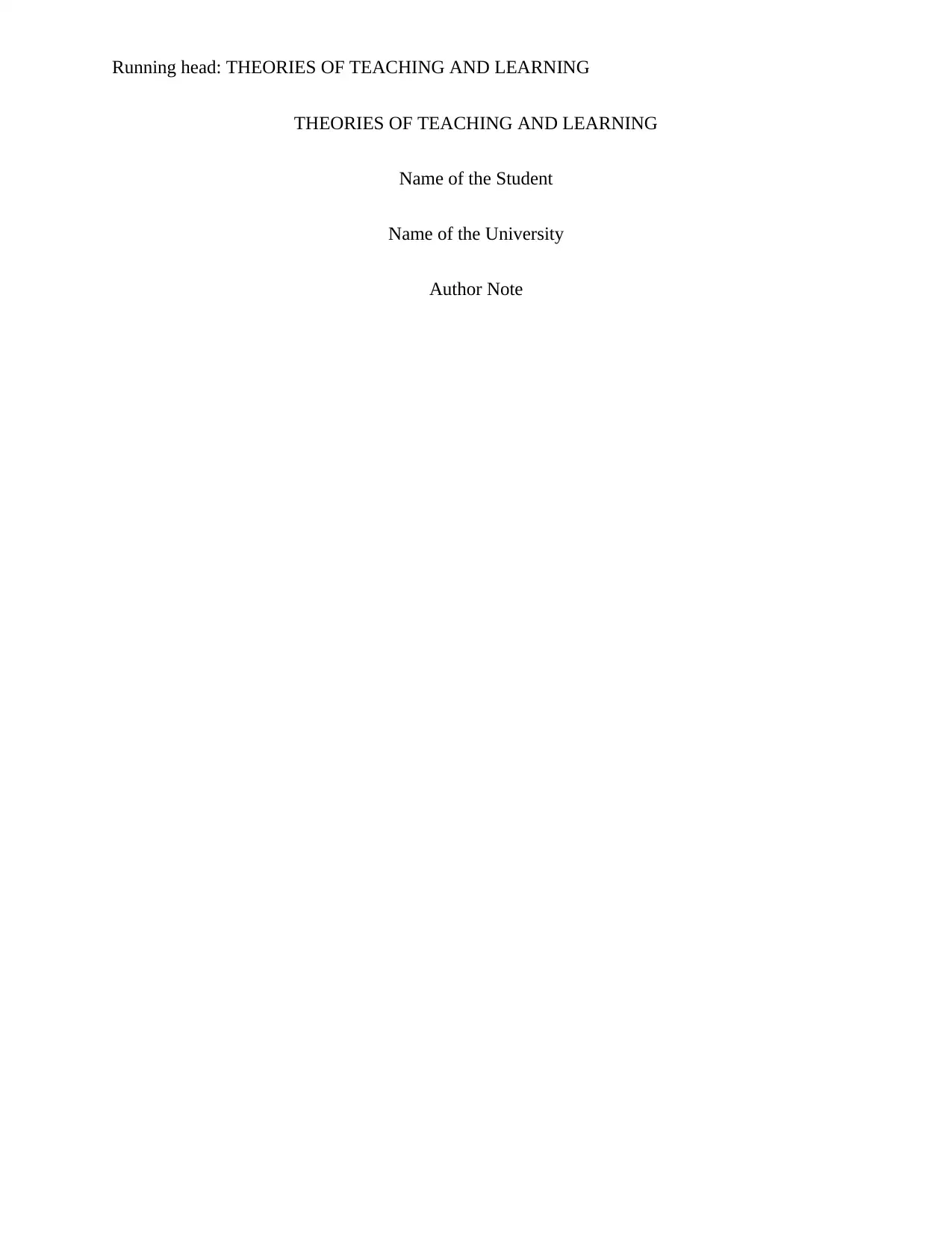
Running head: THEORIES OF TEACHING AND LEARNING
THEORIES OF TEACHING AND LEARNING
Name of the Student
Name of the University
Author Note
THEORIES OF TEACHING AND LEARNING
Name of the Student
Name of the University
Author Note
Paraphrase This Document
Need a fresh take? Get an instant paraphrase of this document with our AI Paraphraser
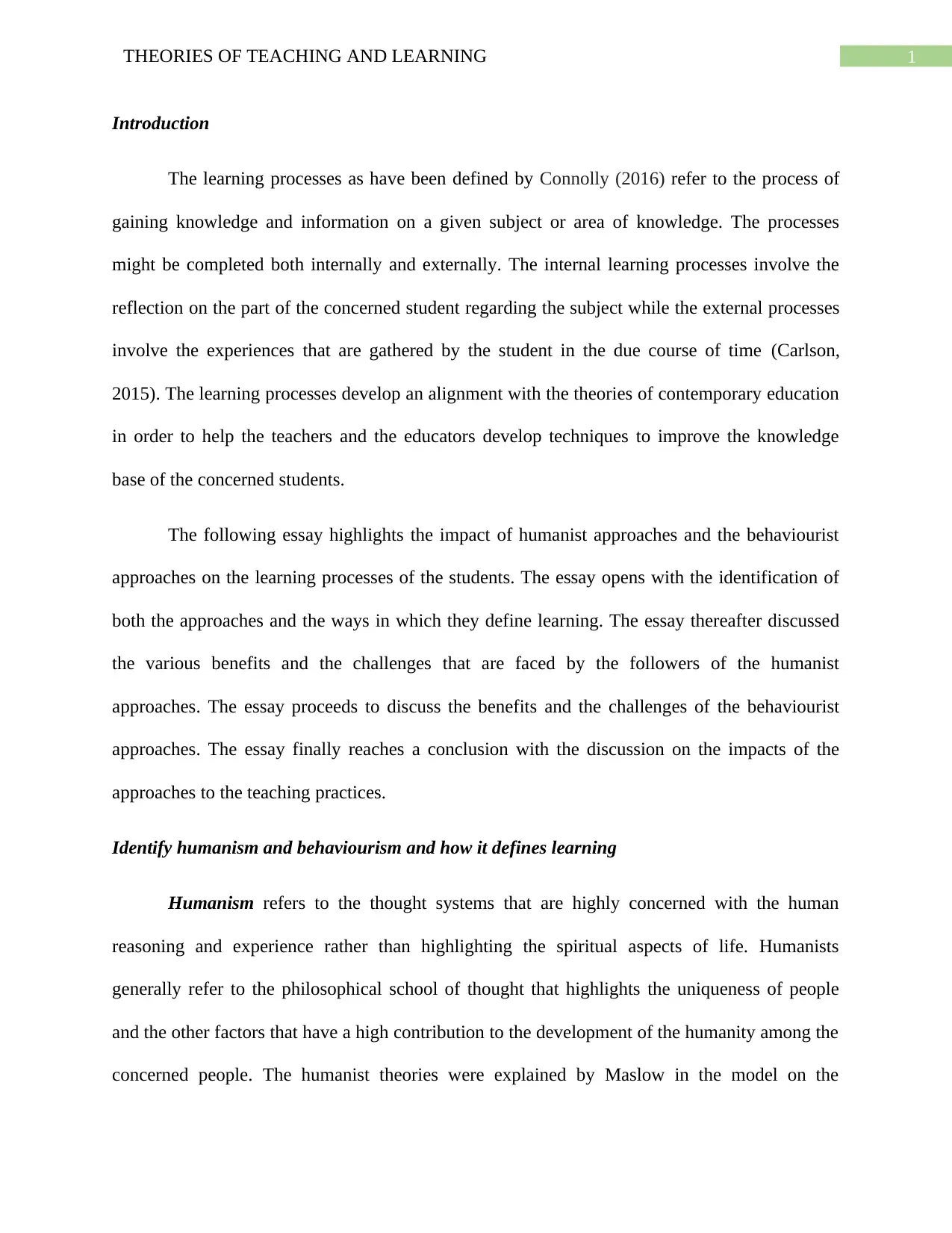
1THEORIES OF TEACHING AND LEARNING
Introduction
The learning processes as have been defined by Connolly (2016) refer to the process of
gaining knowledge and information on a given subject or area of knowledge. The processes
might be completed both internally and externally. The internal learning processes involve the
reflection on the part of the concerned student regarding the subject while the external processes
involve the experiences that are gathered by the student in the due course of time (Carlson,
2015). The learning processes develop an alignment with the theories of contemporary education
in order to help the teachers and the educators develop techniques to improve the knowledge
base of the concerned students.
The following essay highlights the impact of humanist approaches and the behaviourist
approaches on the learning processes of the students. The essay opens with the identification of
both the approaches and the ways in which they define learning. The essay thereafter discussed
the various benefits and the challenges that are faced by the followers of the humanist
approaches. The essay proceeds to discuss the benefits and the challenges of the behaviourist
approaches. The essay finally reaches a conclusion with the discussion on the impacts of the
approaches to the teaching practices.
Identify humanism and behaviourism and how it defines learning
Humanism refers to the thought systems that are highly concerned with the human
reasoning and experience rather than highlighting the spiritual aspects of life. Humanists
generally refer to the philosophical school of thought that highlights the uniqueness of people
and the other factors that have a high contribution to the development of the humanity among the
concerned people. The humanist theories were explained by Maslow in the model on the
Introduction
The learning processes as have been defined by Connolly (2016) refer to the process of
gaining knowledge and information on a given subject or area of knowledge. The processes
might be completed both internally and externally. The internal learning processes involve the
reflection on the part of the concerned student regarding the subject while the external processes
involve the experiences that are gathered by the student in the due course of time (Carlson,
2015). The learning processes develop an alignment with the theories of contemporary education
in order to help the teachers and the educators develop techniques to improve the knowledge
base of the concerned students.
The following essay highlights the impact of humanist approaches and the behaviourist
approaches on the learning processes of the students. The essay opens with the identification of
both the approaches and the ways in which they define learning. The essay thereafter discussed
the various benefits and the challenges that are faced by the followers of the humanist
approaches. The essay proceeds to discuss the benefits and the challenges of the behaviourist
approaches. The essay finally reaches a conclusion with the discussion on the impacts of the
approaches to the teaching practices.
Identify humanism and behaviourism and how it defines learning
Humanism refers to the thought systems that are highly concerned with the human
reasoning and experience rather than highlighting the spiritual aspects of life. Humanists
generally refer to the philosophical school of thought that highlights the uniqueness of people
and the other factors that have a high contribution to the development of the humanity among the
concerned people. The humanist theories were explained by Maslow in the model on the
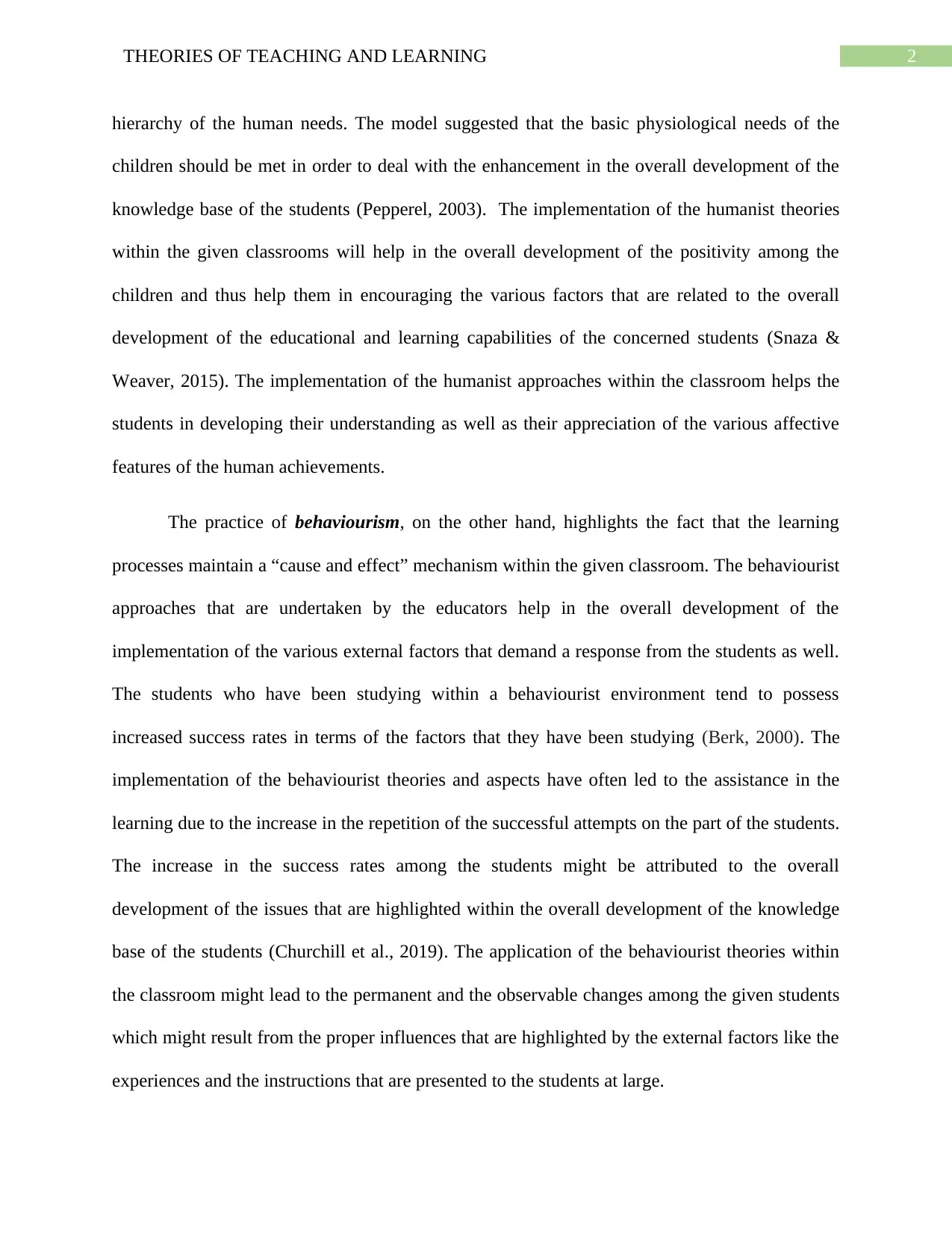
2THEORIES OF TEACHING AND LEARNING
hierarchy of the human needs. The model suggested that the basic physiological needs of the
children should be met in order to deal with the enhancement in the overall development of the
knowledge base of the students (Pepperel, 2003). The implementation of the humanist theories
within the given classrooms will help in the overall development of the positivity among the
children and thus help them in encouraging the various factors that are related to the overall
development of the educational and learning capabilities of the concerned students (Snaza &
Weaver, 2015). The implementation of the humanist approaches within the classroom helps the
students in developing their understanding as well as their appreciation of the various affective
features of the human achievements.
The practice of behaviourism, on the other hand, highlights the fact that the learning
processes maintain a “cause and effect” mechanism within the given classroom. The behaviourist
approaches that are undertaken by the educators help in the overall development of the
implementation of the various external factors that demand a response from the students as well.
The students who have been studying within a behaviourist environment tend to possess
increased success rates in terms of the factors that they have been studying (Berk, 2000). The
implementation of the behaviourist theories and aspects have often led to the assistance in the
learning due to the increase in the repetition of the successful attempts on the part of the students.
The increase in the success rates among the students might be attributed to the overall
development of the issues that are highlighted within the overall development of the knowledge
base of the students (Churchill et al., 2019). The application of the behaviourist theories within
the classroom might lead to the permanent and the observable changes among the given students
which might result from the proper influences that are highlighted by the external factors like the
experiences and the instructions that are presented to the students at large.
hierarchy of the human needs. The model suggested that the basic physiological needs of the
children should be met in order to deal with the enhancement in the overall development of the
knowledge base of the students (Pepperel, 2003). The implementation of the humanist theories
within the given classrooms will help in the overall development of the positivity among the
children and thus help them in encouraging the various factors that are related to the overall
development of the educational and learning capabilities of the concerned students (Snaza &
Weaver, 2015). The implementation of the humanist approaches within the classroom helps the
students in developing their understanding as well as their appreciation of the various affective
features of the human achievements.
The practice of behaviourism, on the other hand, highlights the fact that the learning
processes maintain a “cause and effect” mechanism within the given classroom. The behaviourist
approaches that are undertaken by the educators help in the overall development of the
implementation of the various external factors that demand a response from the students as well.
The students who have been studying within a behaviourist environment tend to possess
increased success rates in terms of the factors that they have been studying (Berk, 2000). The
implementation of the behaviourist theories and aspects have often led to the assistance in the
learning due to the increase in the repetition of the successful attempts on the part of the students.
The increase in the success rates among the students might be attributed to the overall
development of the issues that are highlighted within the overall development of the knowledge
base of the students (Churchill et al., 2019). The application of the behaviourist theories within
the classroom might lead to the permanent and the observable changes among the given students
which might result from the proper influences that are highlighted by the external factors like the
experiences and the instructions that are presented to the students at large.
⊘ This is a preview!⊘
Do you want full access?
Subscribe today to unlock all pages.

Trusted by 1+ million students worldwide
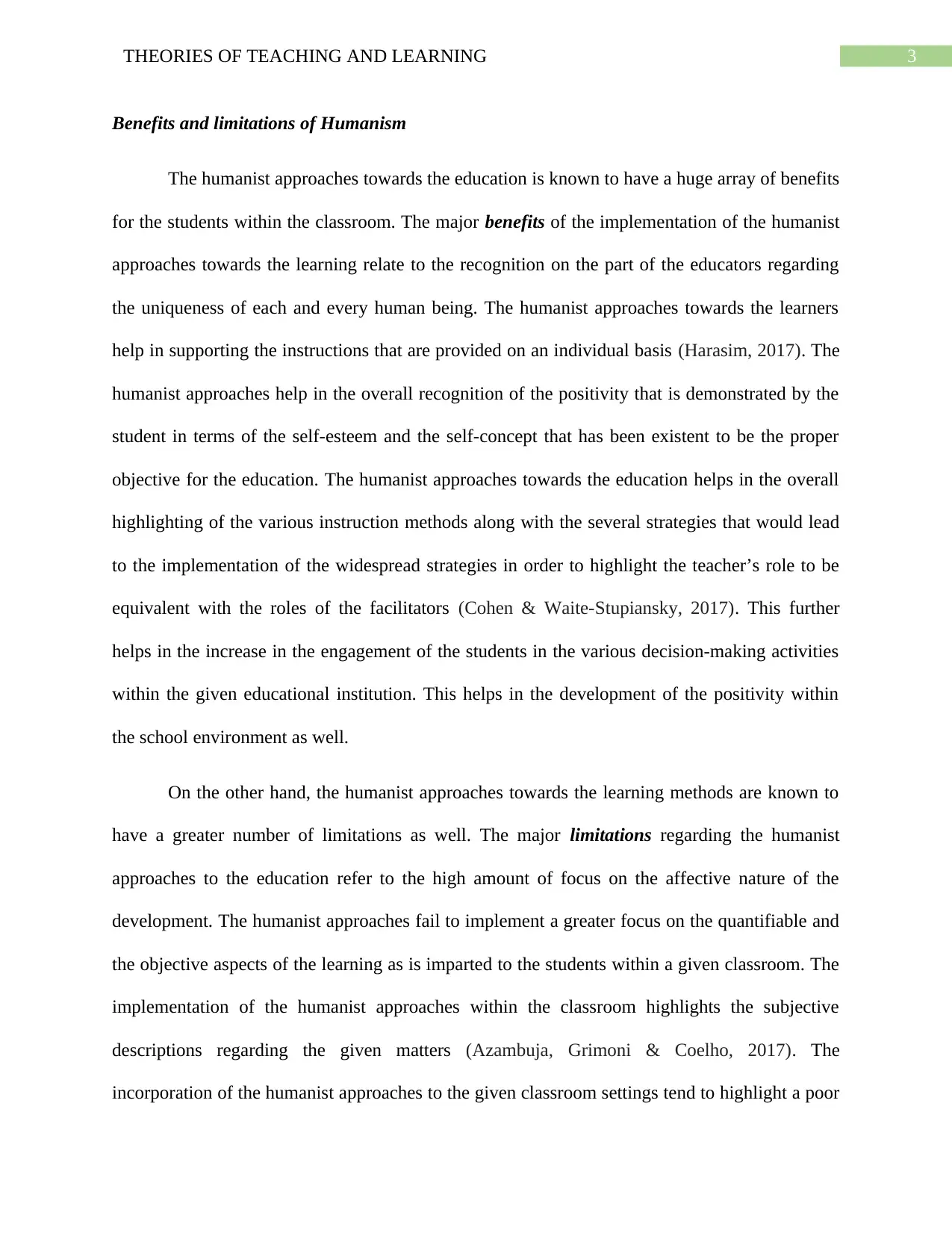
3THEORIES OF TEACHING AND LEARNING
Benefits and limitations of Humanism
The humanist approaches towards the education is known to have a huge array of benefits
for the students within the classroom. The major benefits of the implementation of the humanist
approaches towards the learning relate to the recognition on the part of the educators regarding
the uniqueness of each and every human being. The humanist approaches towards the learners
help in supporting the instructions that are provided on an individual basis (Harasim, 2017). The
humanist approaches help in the overall recognition of the positivity that is demonstrated by the
student in terms of the self-esteem and the self-concept that has been existent to be the proper
objective for the education. The humanist approaches towards the education helps in the overall
highlighting of the various instruction methods along with the several strategies that would lead
to the implementation of the widespread strategies in order to highlight the teacher’s role to be
equivalent with the roles of the facilitators (Cohen & Waite-Stupiansky, 2017). This further
helps in the increase in the engagement of the students in the various decision-making activities
within the given educational institution. This helps in the development of the positivity within
the school environment as well.
On the other hand, the humanist approaches towards the learning methods are known to
have a greater number of limitations as well. The major limitations regarding the humanist
approaches to the education refer to the high amount of focus on the affective nature of the
development. The humanist approaches fail to implement a greater focus on the quantifiable and
the objective aspects of the learning as is imparted to the students within a given classroom. The
implementation of the humanist approaches within the classroom highlights the subjective
descriptions regarding the given matters (Azambuja, Grimoni & Coelho, 2017). The
incorporation of the humanist approaches to the given classroom settings tend to highlight a poor
Benefits and limitations of Humanism
The humanist approaches towards the education is known to have a huge array of benefits
for the students within the classroom. The major benefits of the implementation of the humanist
approaches towards the learning relate to the recognition on the part of the educators regarding
the uniqueness of each and every human being. The humanist approaches towards the learners
help in supporting the instructions that are provided on an individual basis (Harasim, 2017). The
humanist approaches help in the overall recognition of the positivity that is demonstrated by the
student in terms of the self-esteem and the self-concept that has been existent to be the proper
objective for the education. The humanist approaches towards the education helps in the overall
highlighting of the various instruction methods along with the several strategies that would lead
to the implementation of the widespread strategies in order to highlight the teacher’s role to be
equivalent with the roles of the facilitators (Cohen & Waite-Stupiansky, 2017). This further
helps in the increase in the engagement of the students in the various decision-making activities
within the given educational institution. This helps in the development of the positivity within
the school environment as well.
On the other hand, the humanist approaches towards the learning methods are known to
have a greater number of limitations as well. The major limitations regarding the humanist
approaches to the education refer to the high amount of focus on the affective nature of the
development. The humanist approaches fail to implement a greater focus on the quantifiable and
the objective aspects of the learning as is imparted to the students within a given classroom. The
implementation of the humanist approaches within the classroom highlights the subjective
descriptions regarding the given matters (Azambuja, Grimoni & Coelho, 2017). The
incorporation of the humanist approaches to the given classroom settings tend to highlight a poor
Paraphrase This Document
Need a fresh take? Get an instant paraphrase of this document with our AI Paraphraser
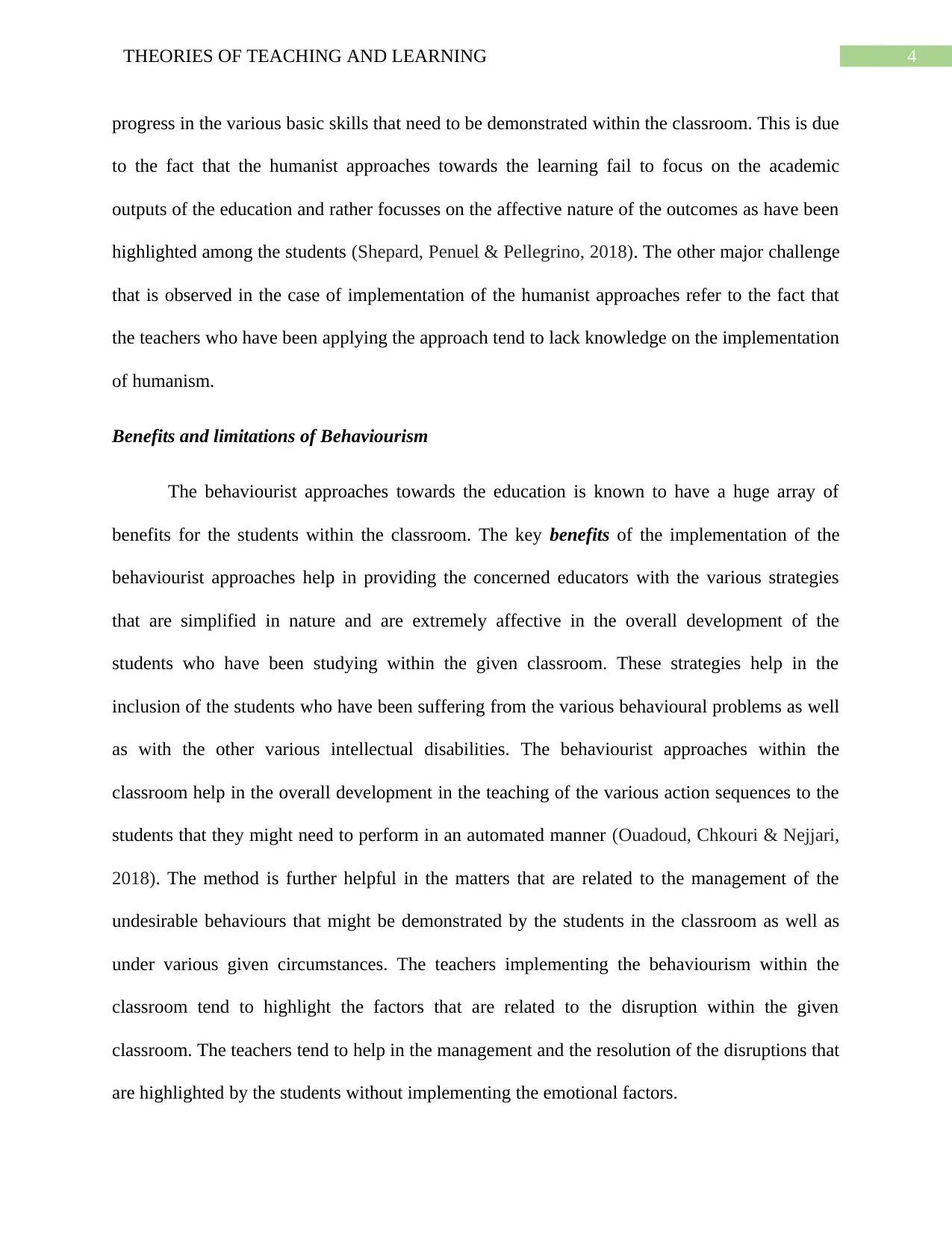
4THEORIES OF TEACHING AND LEARNING
progress in the various basic skills that need to be demonstrated within the classroom. This is due
to the fact that the humanist approaches towards the learning fail to focus on the academic
outputs of the education and rather focusses on the affective nature of the outcomes as have been
highlighted among the students (Shepard, Penuel & Pellegrino, 2018). The other major challenge
that is observed in the case of implementation of the humanist approaches refer to the fact that
the teachers who have been applying the approach tend to lack knowledge on the implementation
of humanism.
Benefits and limitations of Behaviourism
The behaviourist approaches towards the education is known to have a huge array of
benefits for the students within the classroom. The key benefits of the implementation of the
behaviourist approaches help in providing the concerned educators with the various strategies
that are simplified in nature and are extremely affective in the overall development of the
students who have been studying within the given classroom. These strategies help in the
inclusion of the students who have been suffering from the various behavioural problems as well
as with the other various intellectual disabilities. The behaviourist approaches within the
classroom help in the overall development in the teaching of the various action sequences to the
students that they might need to perform in an automated manner (Ouadoud, Chkouri & Nejjari,
2018). The method is further helpful in the matters that are related to the management of the
undesirable behaviours that might be demonstrated by the students in the classroom as well as
under various given circumstances. The teachers implementing the behaviourism within the
classroom tend to highlight the factors that are related to the disruption within the given
classroom. The teachers tend to help in the management and the resolution of the disruptions that
are highlighted by the students without implementing the emotional factors.
progress in the various basic skills that need to be demonstrated within the classroom. This is due
to the fact that the humanist approaches towards the learning fail to focus on the academic
outputs of the education and rather focusses on the affective nature of the outcomes as have been
highlighted among the students (Shepard, Penuel & Pellegrino, 2018). The other major challenge
that is observed in the case of implementation of the humanist approaches refer to the fact that
the teachers who have been applying the approach tend to lack knowledge on the implementation
of humanism.
Benefits and limitations of Behaviourism
The behaviourist approaches towards the education is known to have a huge array of
benefits for the students within the classroom. The key benefits of the implementation of the
behaviourist approaches help in providing the concerned educators with the various strategies
that are simplified in nature and are extremely affective in the overall development of the
students who have been studying within the given classroom. These strategies help in the
inclusion of the students who have been suffering from the various behavioural problems as well
as with the other various intellectual disabilities. The behaviourist approaches within the
classroom help in the overall development in the teaching of the various action sequences to the
students that they might need to perform in an automated manner (Ouadoud, Chkouri & Nejjari,
2018). The method is further helpful in the matters that are related to the management of the
undesirable behaviours that might be demonstrated by the students in the classroom as well as
under various given circumstances. The teachers implementing the behaviourism within the
classroom tend to highlight the factors that are related to the disruption within the given
classroom. The teachers tend to help in the management and the resolution of the disruptions that
are highlighted by the students without implementing the emotional factors.
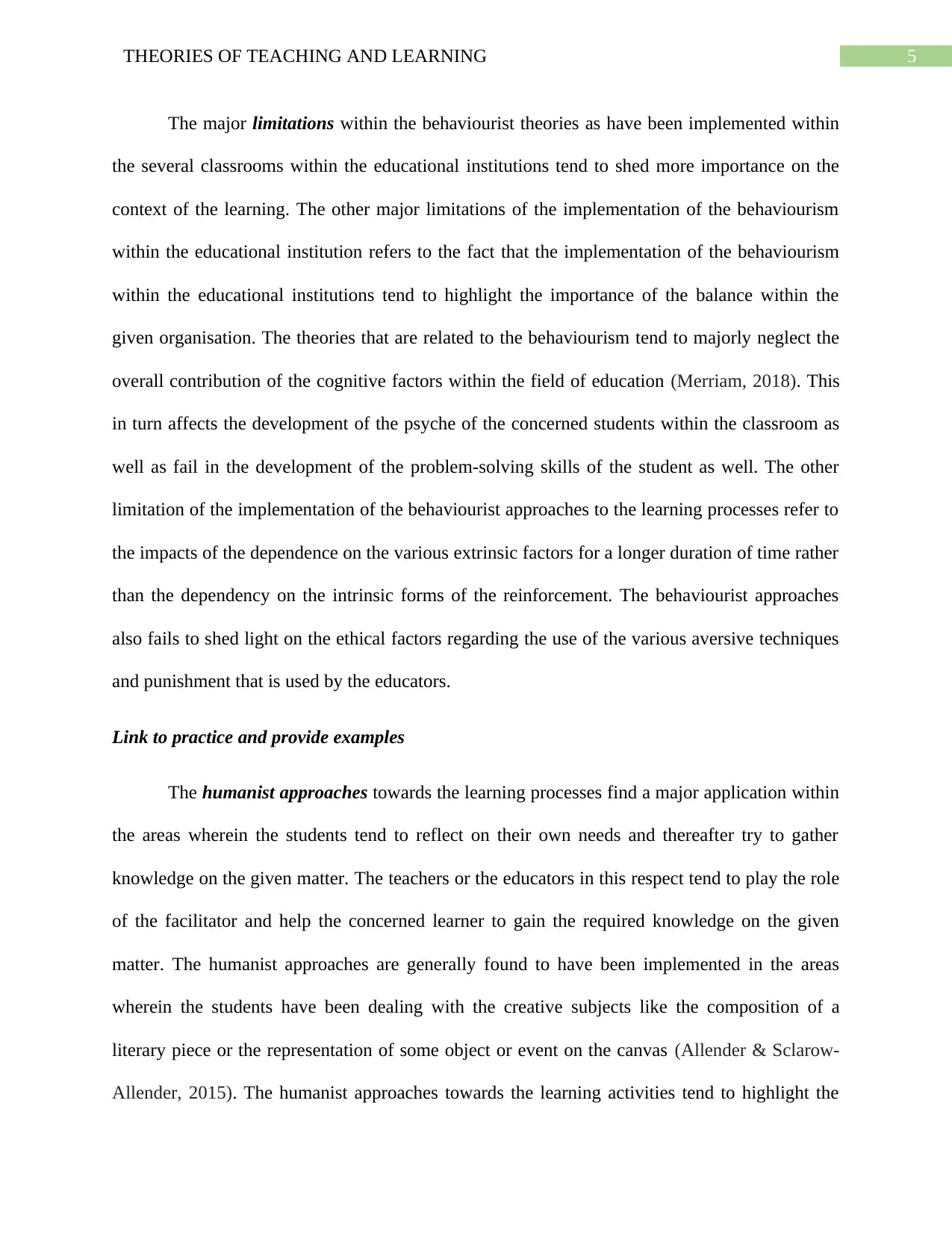
5THEORIES OF TEACHING AND LEARNING
The major limitations within the behaviourist theories as have been implemented within
the several classrooms within the educational institutions tend to shed more importance on the
context of the learning. The other major limitations of the implementation of the behaviourism
within the educational institution refers to the fact that the implementation of the behaviourism
within the educational institutions tend to highlight the importance of the balance within the
given organisation. The theories that are related to the behaviourism tend to majorly neglect the
overall contribution of the cognitive factors within the field of education (Merriam, 2018). This
in turn affects the development of the psyche of the concerned students within the classroom as
well as fail in the development of the problem-solving skills of the student as well. The other
limitation of the implementation of the behaviourist approaches to the learning processes refer to
the impacts of the dependence on the various extrinsic factors for a longer duration of time rather
than the dependency on the intrinsic forms of the reinforcement. The behaviourist approaches
also fails to shed light on the ethical factors regarding the use of the various aversive techniques
and punishment that is used by the educators.
Link to practice and provide examples
The humanist approaches towards the learning processes find a major application within
the areas wherein the students tend to reflect on their own needs and thereafter try to gather
knowledge on the given matter. The teachers or the educators in this respect tend to play the role
of the facilitator and help the concerned learner to gain the required knowledge on the given
matter. The humanist approaches are generally found to have been implemented in the areas
wherein the students have been dealing with the creative subjects like the composition of a
literary piece or the representation of some object or event on the canvas (Allender & Sclarow-
Allender, 2015). The humanist approaches towards the learning activities tend to highlight the
The major limitations within the behaviourist theories as have been implemented within
the several classrooms within the educational institutions tend to shed more importance on the
context of the learning. The other major limitations of the implementation of the behaviourism
within the educational institution refers to the fact that the implementation of the behaviourism
within the educational institutions tend to highlight the importance of the balance within the
given organisation. The theories that are related to the behaviourism tend to majorly neglect the
overall contribution of the cognitive factors within the field of education (Merriam, 2018). This
in turn affects the development of the psyche of the concerned students within the classroom as
well as fail in the development of the problem-solving skills of the student as well. The other
limitation of the implementation of the behaviourist approaches to the learning processes refer to
the impacts of the dependence on the various extrinsic factors for a longer duration of time rather
than the dependency on the intrinsic forms of the reinforcement. The behaviourist approaches
also fails to shed light on the ethical factors regarding the use of the various aversive techniques
and punishment that is used by the educators.
Link to practice and provide examples
The humanist approaches towards the learning processes find a major application within
the areas wherein the students tend to reflect on their own needs and thereafter try to gather
knowledge on the given matter. The teachers or the educators in this respect tend to play the role
of the facilitator and help the concerned learner to gain the required knowledge on the given
matter. The humanist approaches are generally found to have been implemented in the areas
wherein the students have been dealing with the creative subjects like the composition of a
literary piece or the representation of some object or event on the canvas (Allender & Sclarow-
Allender, 2015). The humanist approaches towards the learning activities tend to highlight the
⊘ This is a preview!⊘
Do you want full access?
Subscribe today to unlock all pages.

Trusted by 1+ million students worldwide
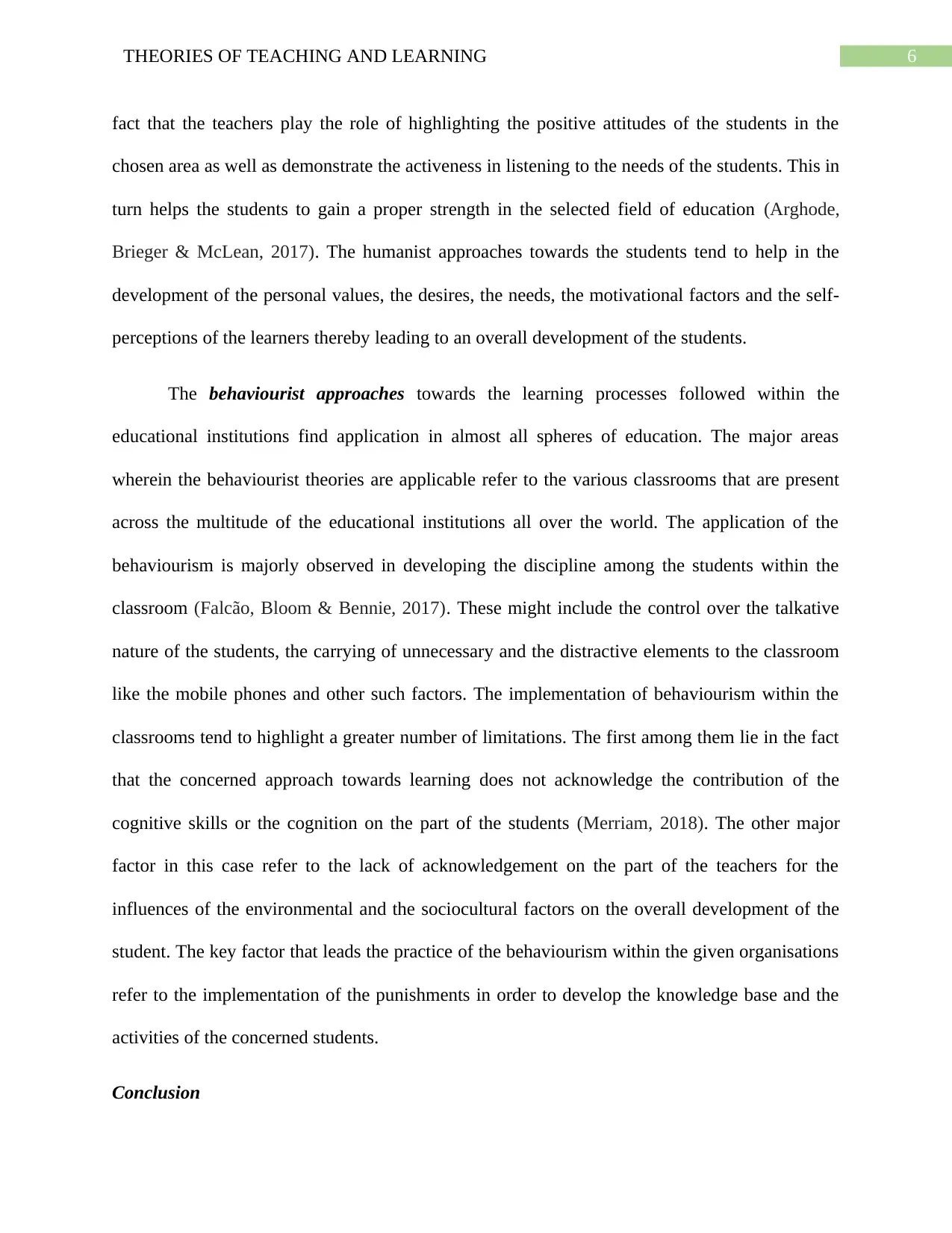
6THEORIES OF TEACHING AND LEARNING
fact that the teachers play the role of highlighting the positive attitudes of the students in the
chosen area as well as demonstrate the activeness in listening to the needs of the students. This in
turn helps the students to gain a proper strength in the selected field of education (Arghode,
Brieger & McLean, 2017). The humanist approaches towards the students tend to help in the
development of the personal values, the desires, the needs, the motivational factors and the self-
perceptions of the learners thereby leading to an overall development of the students.
The behaviourist approaches towards the learning processes followed within the
educational institutions find application in almost all spheres of education. The major areas
wherein the behaviourist theories are applicable refer to the various classrooms that are present
across the multitude of the educational institutions all over the world. The application of the
behaviourism is majorly observed in developing the discipline among the students within the
classroom (Falcão, Bloom & Bennie, 2017). These might include the control over the talkative
nature of the students, the carrying of unnecessary and the distractive elements to the classroom
like the mobile phones and other such factors. The implementation of behaviourism within the
classrooms tend to highlight a greater number of limitations. The first among them lie in the fact
that the concerned approach towards learning does not acknowledge the contribution of the
cognitive skills or the cognition on the part of the students (Merriam, 2018). The other major
factor in this case refer to the lack of acknowledgement on the part of the teachers for the
influences of the environmental and the sociocultural factors on the overall development of the
student. The key factor that leads the practice of the behaviourism within the given organisations
refer to the implementation of the punishments in order to develop the knowledge base and the
activities of the concerned students.
Conclusion
fact that the teachers play the role of highlighting the positive attitudes of the students in the
chosen area as well as demonstrate the activeness in listening to the needs of the students. This in
turn helps the students to gain a proper strength in the selected field of education (Arghode,
Brieger & McLean, 2017). The humanist approaches towards the students tend to help in the
development of the personal values, the desires, the needs, the motivational factors and the self-
perceptions of the learners thereby leading to an overall development of the students.
The behaviourist approaches towards the learning processes followed within the
educational institutions find application in almost all spheres of education. The major areas
wherein the behaviourist theories are applicable refer to the various classrooms that are present
across the multitude of the educational institutions all over the world. The application of the
behaviourism is majorly observed in developing the discipline among the students within the
classroom (Falcão, Bloom & Bennie, 2017). These might include the control over the talkative
nature of the students, the carrying of unnecessary and the distractive elements to the classroom
like the mobile phones and other such factors. The implementation of behaviourism within the
classrooms tend to highlight a greater number of limitations. The first among them lie in the fact
that the concerned approach towards learning does not acknowledge the contribution of the
cognitive skills or the cognition on the part of the students (Merriam, 2018). The other major
factor in this case refer to the lack of acknowledgement on the part of the teachers for the
influences of the environmental and the sociocultural factors on the overall development of the
student. The key factor that leads the practice of the behaviourism within the given organisations
refer to the implementation of the punishments in order to develop the knowledge base and the
activities of the concerned students.
Conclusion
Paraphrase This Document
Need a fresh take? Get an instant paraphrase of this document with our AI Paraphraser
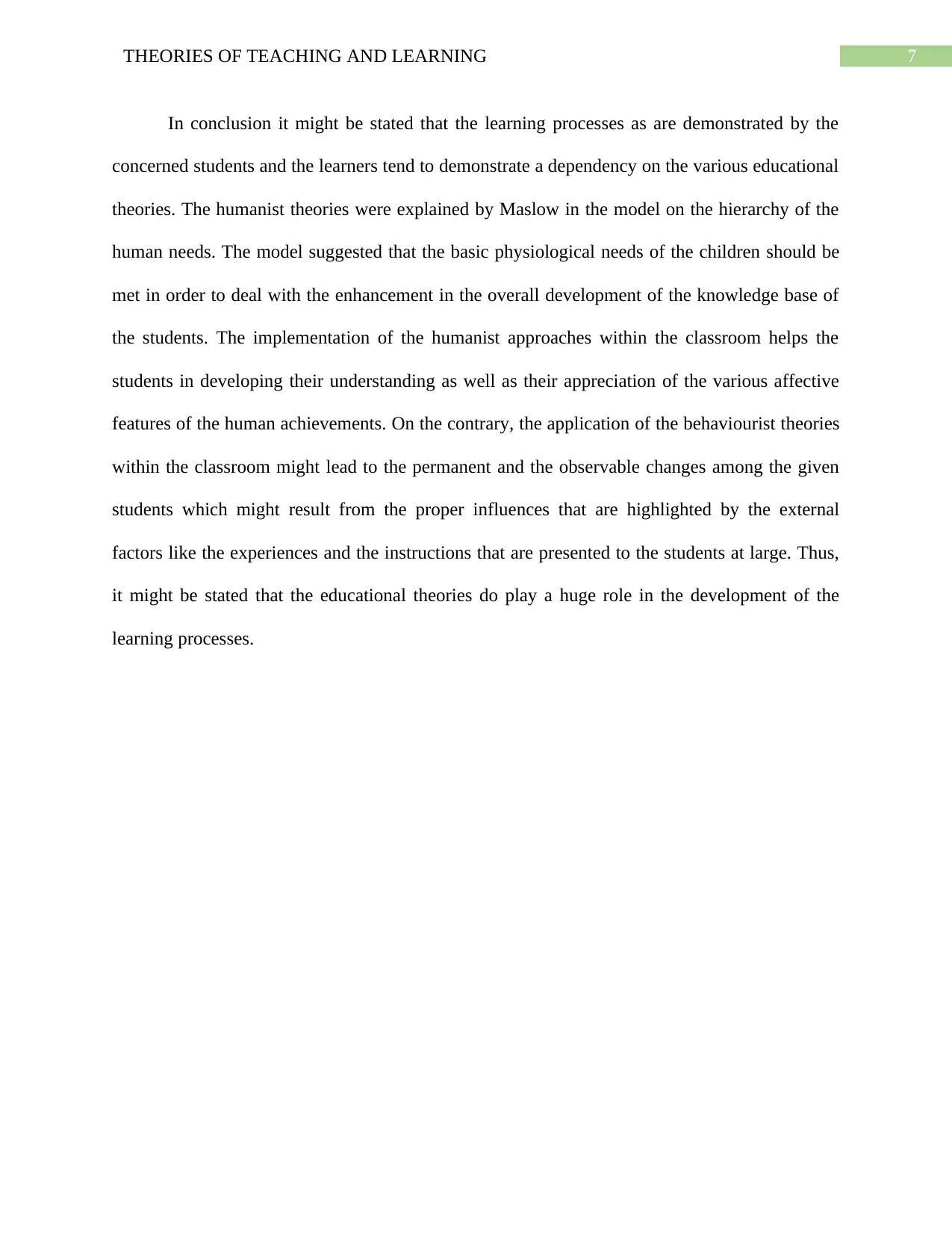
7THEORIES OF TEACHING AND LEARNING
In conclusion it might be stated that the learning processes as are demonstrated by the
concerned students and the learners tend to demonstrate a dependency on the various educational
theories. The humanist theories were explained by Maslow in the model on the hierarchy of the
human needs. The model suggested that the basic physiological needs of the children should be
met in order to deal with the enhancement in the overall development of the knowledge base of
the students. The implementation of the humanist approaches within the classroom helps the
students in developing their understanding as well as their appreciation of the various affective
features of the human achievements. On the contrary, the application of the behaviourist theories
within the classroom might lead to the permanent and the observable changes among the given
students which might result from the proper influences that are highlighted by the external
factors like the experiences and the instructions that are presented to the students at large. Thus,
it might be stated that the educational theories do play a huge role in the development of the
learning processes.
In conclusion it might be stated that the learning processes as are demonstrated by the
concerned students and the learners tend to demonstrate a dependency on the various educational
theories. The humanist theories were explained by Maslow in the model on the hierarchy of the
human needs. The model suggested that the basic physiological needs of the children should be
met in order to deal with the enhancement in the overall development of the knowledge base of
the students. The implementation of the humanist approaches within the classroom helps the
students in developing their understanding as well as their appreciation of the various affective
features of the human achievements. On the contrary, the application of the behaviourist theories
within the classroom might lead to the permanent and the observable changes among the given
students which might result from the proper influences that are highlighted by the external
factors like the experiences and the instructions that are presented to the students at large. Thus,
it might be stated that the educational theories do play a huge role in the development of the
learning processes.
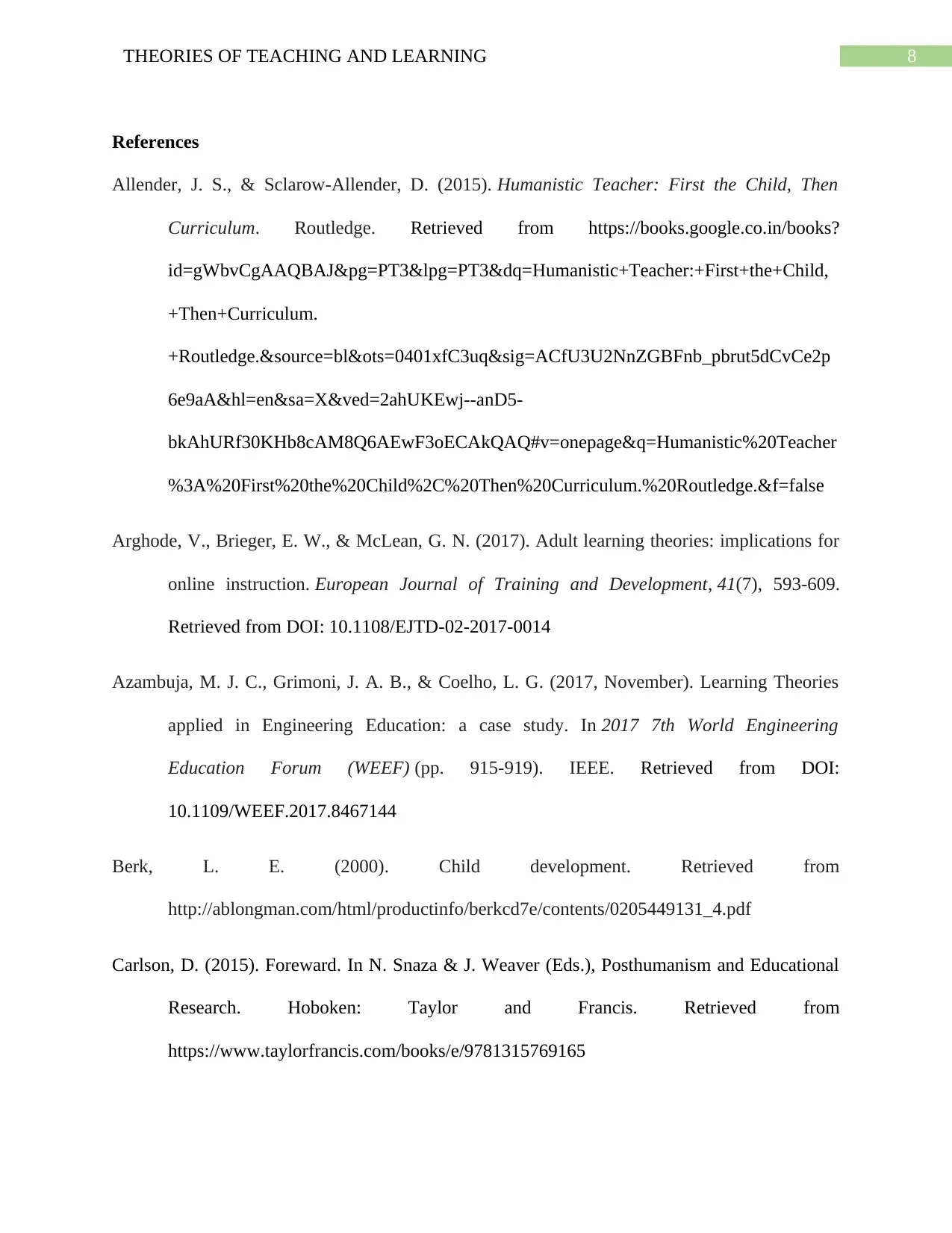
8THEORIES OF TEACHING AND LEARNING
References
Allender, J. S., & Sclarow-Allender, D. (2015). Humanistic Teacher: First the Child, Then
Curriculum. Routledge. Retrieved from https://books.google.co.in/books?
id=gWbvCgAAQBAJ&pg=PT3&lpg=PT3&dq=Humanistic+Teacher:+First+the+Child,
+Then+Curriculum.
+Routledge.&source=bl&ots=0401xfC3uq&sig=ACfU3U2NnZGBFnb_pbrut5dCvCe2p
6e9aA&hl=en&sa=X&ved=2ahUKEwj--anD5-
bkAhURf30KHb8cAM8Q6AEwF3oECAkQAQ#v=onepage&q=Humanistic%20Teacher
%3A%20First%20the%20Child%2C%20Then%20Curriculum.%20Routledge.&f=false
Arghode, V., Brieger, E. W., & McLean, G. N. (2017). Adult learning theories: implications for
online instruction. European Journal of Training and Development, 41(7), 593-609.
Retrieved from DOI: 10.1108/EJTD-02-2017-0014
Azambuja, M. J. C., Grimoni, J. A. B., & Coelho, L. G. (2017, November). Learning Theories
applied in Engineering Education: a case study. In 2017 7th World Engineering
Education Forum (WEEF) (pp. 915-919). IEEE. Retrieved from DOI:
10.1109/WEEF.2017.8467144
Berk, L. E. (2000). Child development. Retrieved from
http://ablongman.com/html/productinfo/berkcd7e/contents/0205449131_4.pdf
Carlson, D. (2015). Foreward. In N. Snaza & J. Weaver (Eds.), Posthumanism and Educational
Research. Hoboken: Taylor and Francis. Retrieved from
https://www.taylorfrancis.com/books/e/9781315769165
References
Allender, J. S., & Sclarow-Allender, D. (2015). Humanistic Teacher: First the Child, Then
Curriculum. Routledge. Retrieved from https://books.google.co.in/books?
id=gWbvCgAAQBAJ&pg=PT3&lpg=PT3&dq=Humanistic+Teacher:+First+the+Child,
+Then+Curriculum.
+Routledge.&source=bl&ots=0401xfC3uq&sig=ACfU3U2NnZGBFnb_pbrut5dCvCe2p
6e9aA&hl=en&sa=X&ved=2ahUKEwj--anD5-
bkAhURf30KHb8cAM8Q6AEwF3oECAkQAQ#v=onepage&q=Humanistic%20Teacher
%3A%20First%20the%20Child%2C%20Then%20Curriculum.%20Routledge.&f=false
Arghode, V., Brieger, E. W., & McLean, G. N. (2017). Adult learning theories: implications for
online instruction. European Journal of Training and Development, 41(7), 593-609.
Retrieved from DOI: 10.1108/EJTD-02-2017-0014
Azambuja, M. J. C., Grimoni, J. A. B., & Coelho, L. G. (2017, November). Learning Theories
applied in Engineering Education: a case study. In 2017 7th World Engineering
Education Forum (WEEF) (pp. 915-919). IEEE. Retrieved from DOI:
10.1109/WEEF.2017.8467144
Berk, L. E. (2000). Child development. Retrieved from
http://ablongman.com/html/productinfo/berkcd7e/contents/0205449131_4.pdf
Carlson, D. (2015). Foreward. In N. Snaza & J. Weaver (Eds.), Posthumanism and Educational
Research. Hoboken: Taylor and Francis. Retrieved from
https://www.taylorfrancis.com/books/e/9781315769165
⊘ This is a preview!⊘
Do you want full access?
Subscribe today to unlock all pages.

Trusted by 1+ million students worldwide
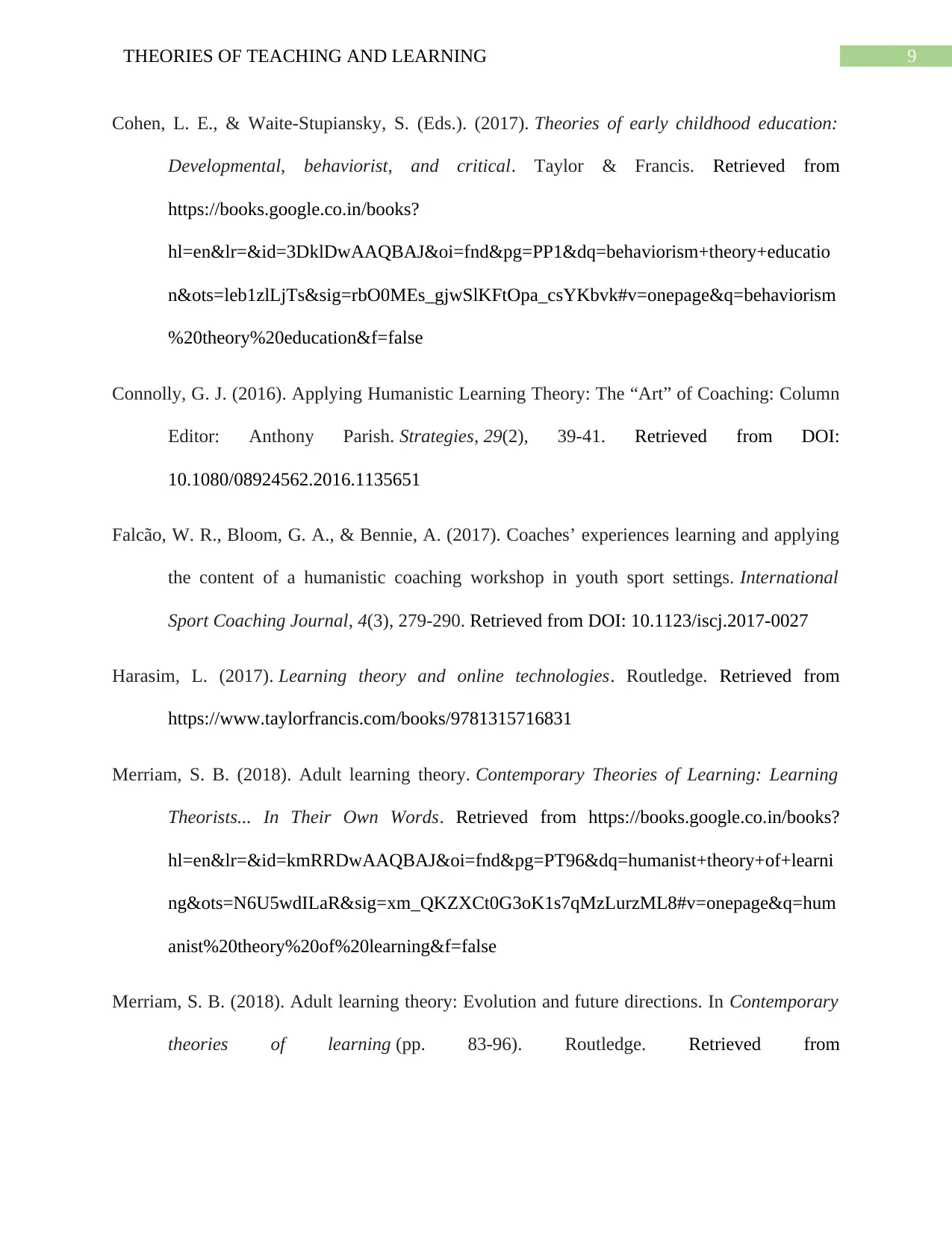
9THEORIES OF TEACHING AND LEARNING
Cohen, L. E., & Waite-Stupiansky, S. (Eds.). (2017). Theories of early childhood education:
Developmental, behaviorist, and critical. Taylor & Francis. Retrieved from
https://books.google.co.in/books?
hl=en&lr=&id=3DklDwAAQBAJ&oi=fnd&pg=PP1&dq=behaviorism+theory+educatio
n&ots=leb1zlLjTs&sig=rbO0MEs_gjwSlKFtOpa_csYKbvk#v=onepage&q=behaviorism
%20theory%20education&f=false
Connolly, G. J. (2016). Applying Humanistic Learning Theory: The “Art” of Coaching: Column
Editor: Anthony Parish. Strategies, 29(2), 39-41. Retrieved from DOI:
10.1080/08924562.2016.1135651
Falcão, W. R., Bloom, G. A., & Bennie, A. (2017). Coaches’ experiences learning and applying
the content of a humanistic coaching workshop in youth sport settings. International
Sport Coaching Journal, 4(3), 279-290. Retrieved from DOI: 10.1123/iscj.2017-0027
Harasim, L. (2017). Learning theory and online technologies. Routledge. Retrieved from
https://www.taylorfrancis.com/books/9781315716831
Merriam, S. B. (2018). Adult learning theory. Contemporary Theories of Learning: Learning
Theorists... In Their Own Words. Retrieved from https://books.google.co.in/books?
hl=en&lr=&id=kmRRDwAAQBAJ&oi=fnd&pg=PT96&dq=humanist+theory+of+learni
ng&ots=N6U5wdILaR&sig=xm_QKZXCt0G3oK1s7qMzLurzML8#v=onepage&q=hum
anist%20theory%20of%20learning&f=false
Merriam, S. B. (2018). Adult learning theory: Evolution and future directions. In Contemporary
theories of learning (pp. 83-96). Routledge. Retrieved from
Cohen, L. E., & Waite-Stupiansky, S. (Eds.). (2017). Theories of early childhood education:
Developmental, behaviorist, and critical. Taylor & Francis. Retrieved from
https://books.google.co.in/books?
hl=en&lr=&id=3DklDwAAQBAJ&oi=fnd&pg=PP1&dq=behaviorism+theory+educatio
n&ots=leb1zlLjTs&sig=rbO0MEs_gjwSlKFtOpa_csYKbvk#v=onepage&q=behaviorism
%20theory%20education&f=false
Connolly, G. J. (2016). Applying Humanistic Learning Theory: The “Art” of Coaching: Column
Editor: Anthony Parish. Strategies, 29(2), 39-41. Retrieved from DOI:
10.1080/08924562.2016.1135651
Falcão, W. R., Bloom, G. A., & Bennie, A. (2017). Coaches’ experiences learning and applying
the content of a humanistic coaching workshop in youth sport settings. International
Sport Coaching Journal, 4(3), 279-290. Retrieved from DOI: 10.1123/iscj.2017-0027
Harasim, L. (2017). Learning theory and online technologies. Routledge. Retrieved from
https://www.taylorfrancis.com/books/9781315716831
Merriam, S. B. (2018). Adult learning theory. Contemporary Theories of Learning: Learning
Theorists... In Their Own Words. Retrieved from https://books.google.co.in/books?
hl=en&lr=&id=kmRRDwAAQBAJ&oi=fnd&pg=PT96&dq=humanist+theory+of+learni
ng&ots=N6U5wdILaR&sig=xm_QKZXCt0G3oK1s7qMzLurzML8#v=onepage&q=hum
anist%20theory%20of%20learning&f=false
Merriam, S. B. (2018). Adult learning theory: Evolution and future directions. In Contemporary
theories of learning (pp. 83-96). Routledge. Retrieved from
Paraphrase This Document
Need a fresh take? Get an instant paraphrase of this document with our AI Paraphraser
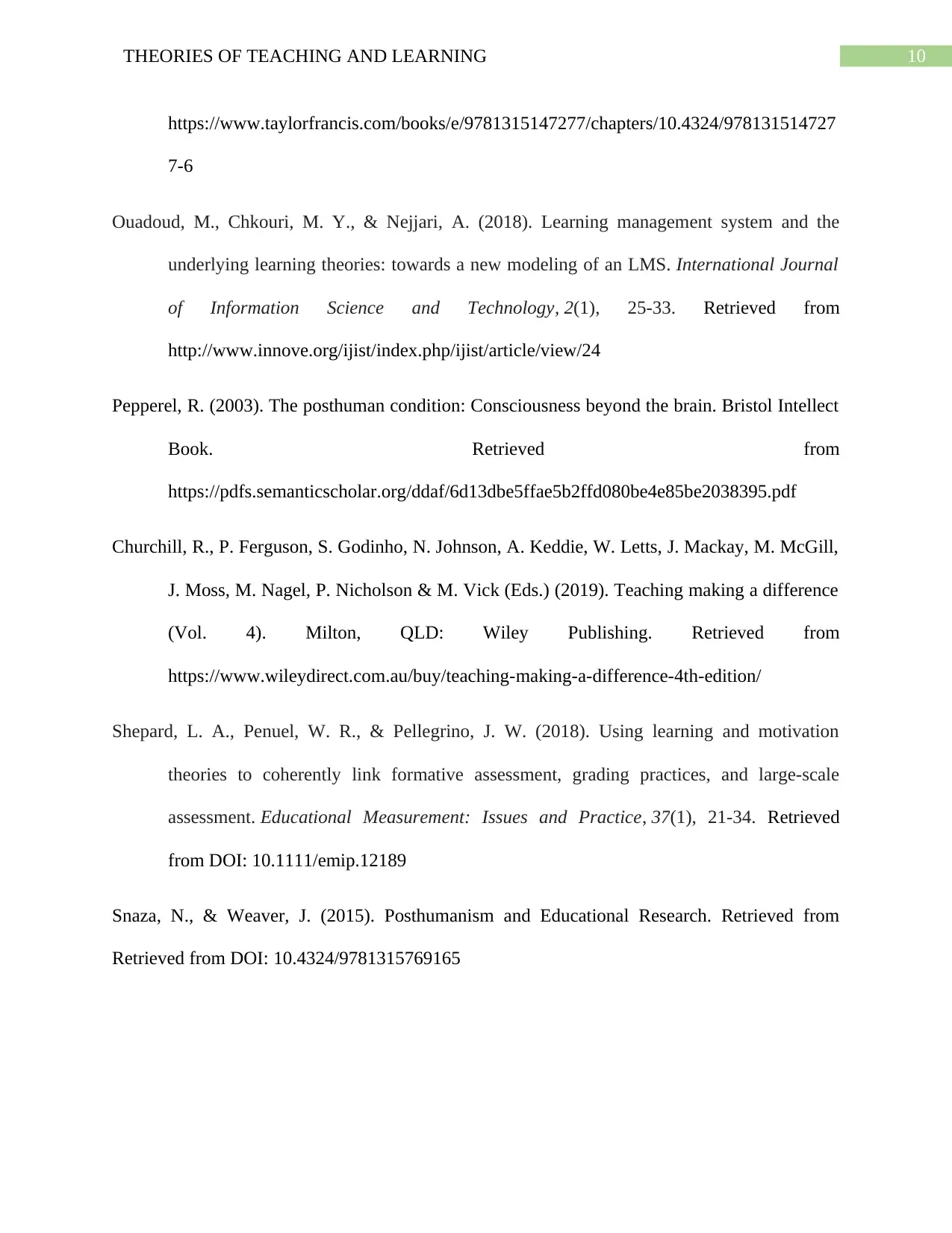
10THEORIES OF TEACHING AND LEARNING
https://www.taylorfrancis.com/books/e/9781315147277/chapters/10.4324/978131514727
7-6
Ouadoud, M., Chkouri, M. Y., & Nejjari, A. (2018). Learning management system and the
underlying learning theories: towards a new modeling of an LMS. International Journal
of Information Science and Technology, 2(1), 25-33. Retrieved from
http://www.innove.org/ijist/index.php/ijist/article/view/24
Pepperel, R. (2003). The posthuman condition: Consciousness beyond the brain. Bristol Intellect
Book. Retrieved from
https://pdfs.semanticscholar.org/ddaf/6d13dbe5ffae5b2ffd080be4e85be2038395.pdf
Churchill, R., P. Ferguson, S. Godinho, N. Johnson, A. Keddie, W. Letts, J. Mackay, M. McGill,
J. Moss, M. Nagel, P. Nicholson & M. Vick (Eds.) (2019). Teaching making a difference
(Vol. 4). Milton, QLD: Wiley Publishing. Retrieved from
https://www.wileydirect.com.au/buy/teaching-making-a-difference-4th-edition/
Shepard, L. A., Penuel, W. R., & Pellegrino, J. W. (2018). Using learning and motivation
theories to coherently link formative assessment, grading practices, and large‐scale
assessment. Educational Measurement: Issues and Practice, 37(1), 21-34. Retrieved
from DOI: 10.1111/emip.12189
Snaza, N., & Weaver, J. (2015). Posthumanism and Educational Research. Retrieved from
Retrieved from DOI: 10.4324/9781315769165
https://www.taylorfrancis.com/books/e/9781315147277/chapters/10.4324/978131514727
7-6
Ouadoud, M., Chkouri, M. Y., & Nejjari, A. (2018). Learning management system and the
underlying learning theories: towards a new modeling of an LMS. International Journal
of Information Science and Technology, 2(1), 25-33. Retrieved from
http://www.innove.org/ijist/index.php/ijist/article/view/24
Pepperel, R. (2003). The posthuman condition: Consciousness beyond the brain. Bristol Intellect
Book. Retrieved from
https://pdfs.semanticscholar.org/ddaf/6d13dbe5ffae5b2ffd080be4e85be2038395.pdf
Churchill, R., P. Ferguson, S. Godinho, N. Johnson, A. Keddie, W. Letts, J. Mackay, M. McGill,
J. Moss, M. Nagel, P. Nicholson & M. Vick (Eds.) (2019). Teaching making a difference
(Vol. 4). Milton, QLD: Wiley Publishing. Retrieved from
https://www.wileydirect.com.au/buy/teaching-making-a-difference-4th-edition/
Shepard, L. A., Penuel, W. R., & Pellegrino, J. W. (2018). Using learning and motivation
theories to coherently link formative assessment, grading practices, and large‐scale
assessment. Educational Measurement: Issues and Practice, 37(1), 21-34. Retrieved
from DOI: 10.1111/emip.12189
Snaza, N., & Weaver, J. (2015). Posthumanism and Educational Research. Retrieved from
Retrieved from DOI: 10.4324/9781315769165
1 out of 11
Related Documents
Your All-in-One AI-Powered Toolkit for Academic Success.
+13062052269
info@desklib.com
Available 24*7 on WhatsApp / Email
![[object Object]](/_next/static/media/star-bottom.7253800d.svg)
Unlock your academic potential
Copyright © 2020–2025 A2Z Services. All Rights Reserved. Developed and managed by ZUCOL.





